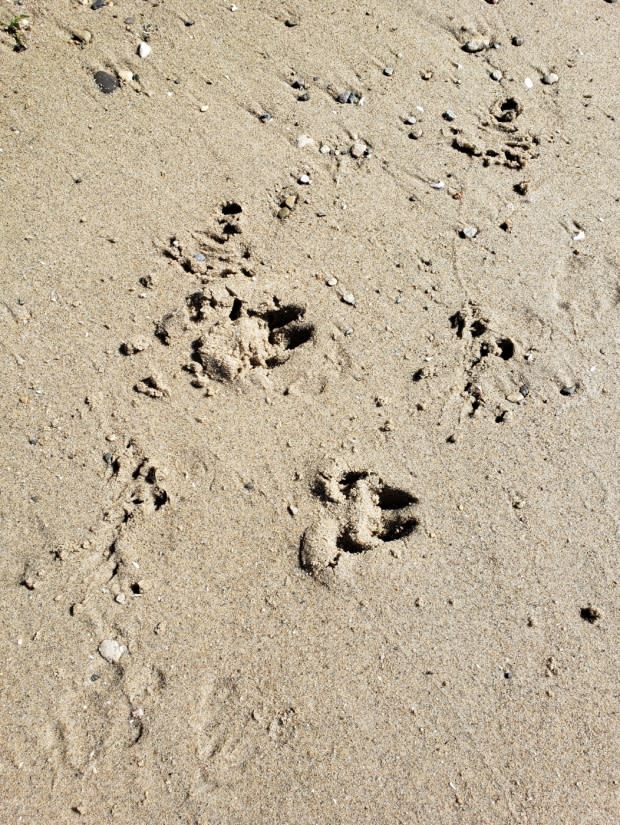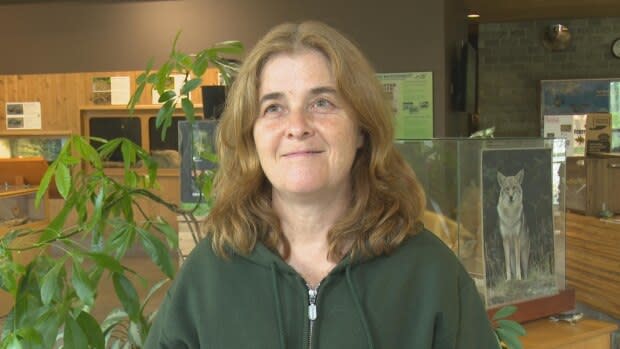'Little black figure in the distance': Windsor man claims wild boar sighting on Peche Island
Windsor resident Kyle Gillis says he saw the little black figure while kayaking almost two weeks ago along the west end of Peche Island.
It was early in the morning, at about 7 a.m. As Gillis got closer to the island, the figure bolted away, running across the beach.
Gillis looked at the tracks left by the creature and took a moment to reflect on the events that had transpired.
He eventually decided that the creature he saw had to have been a wild boar.

"I've never seen anything like it around," said Gillis. "You see them on TV and everything else … Two and two together, it's the only thing it could have been."
Though he wasn't able to capture a photo of the animal in time, he was able to snap a picture of the prints it left in the sand.
Karen Cedar, a naturalist for the City of Windsor who studied Gillis's photo, isn't certain Gillis saw a wild boar.
Though she didn't rule out Gillis's hypothesis, she raised the possibility that the creature could have been a deer — perhaps, even a fallow deer which made its way from Belle Island.

"Some of the fallow deer are quite short … about the same size as you'd expect a boar to be," said Cedar.
Cedar said fallow deer have been residents of Belle Island for several decades, and they've been spotted as far as Dougall Road near the E.C. Row Expressway on the mainland.
Still, Cedar said she couldn't remember if anyone reported a fallow deer sighting on Peche Island.
A spokesperson for the Ontario Ministry of Natural Resources and Forestry (MNR) confirmed that the ministry "received and responded to an email report from Kyle Gillis about his sighting."
"We haven't received additional reports of sightings on Peche Island and naturalists that work there have also not observed any signs of wild pigs," said the MNR spokesperson, in an email. "We cannot confirm whether there is a wild pig on Peche Island."
Wild pigs in Canada
For his part, University of Saskatchewan professor Ryan Brook says he wouldn't be surprised if someone spotted a wild boar on Peche Island.
In addition to his role with the university's College of Agriculture and Bioresources, Brook is the director of the Canadian wild pig research project, which has studied the expansion of wild pigs across the country for the last 10 years.
He conceded his knowledge of the Windsor-Essex region is lacking, but Brook said he isn't surprised to hear that a wild boar may have been spotted on an island in a river — especially since wild pigs were recently spotted on a farm in Chatham, Ont.
Brook also examined Gillis's photo. He said that it's hard to make a definitive statement about the prints because they're in sand, but added they "look quite piggy."

Wild pigs are an invasive species which were introduced to Canada and other parts of North America in the 1980s and early 1990s as a push to diversify agriculture.
Though significant time and money was invested into growing Canada's agricultural wild pig market, the animals failed to generate significant interest.
Brook said some farmers eventually chose to release the animals into the wild, sometimes simply releasing 100 to 300 of the creatures into the wild.
"A large majority of them are found in the praire provinces of Alberta, Saskatchewan and Manitoba, but they have been found and they're known to occur in all provinces, except Atlantic Canada," he said.
Brook explained wild pigs are also "exceptionally good swimming animals."
"In fact, in Hawaii, they will swim in the ocean between islands over quite long distances," said Brook, who added he recently received photos showing wild pigs swimming across Saskatchewan's Lake Diefenbaker.
"They float like crazy, they swim very well and, in fact, one of them was seen to have at least one baby piglet floating on her back," he said.
Like a house on fire
While Canada's wild pig market saw a sharp decline after 2001, Brook said there are still active farms in most provinces.
Brook nonetheless cautioned Ontario should brace for an ecological train wreck if more wild pigs are spotted outside controlled environments.
"They destroy native ecosystems. They can be dangerous to people," said Brook. "The largest animal we've ever handled was 638 pounds, so these animals can be large. They have razor sharp tusks. We do not want these becoming established in your province and causing lots of problems."
He explained wild pigs are rooting animals that dig into the ground and tear it apart in search of roots, insect larva, earthworms and "anything they can dig up to eat."
"After they leave one evening of eating, it looks like a rototiller went through and just tore your prize rosebushes or your lawn or your wheat field," said Brook. "They will eat literally anything."
Wild pigs don't just feast on dry land, either.
The first thing you do is call 911 and get the experts on it. - Ryan Brook, University of Saskatchewan professor
"They come into wetlands, they eat salamanders, frogs, goslings, ducklings, anything that they can catch and eat, they will," said Brook. "They'll rip up nests and eat all the eggs."
Brook likened the spread of wild pigs across Canada to a house fire, adding wild pig sightings should be reported to the authorities.
"If you see someone's house on fire, you don't grab your garden hose and run over and try to put it out. The first thing you do is call 911 and get the experts on it," he said.
Brook also cautioned against attempting to shoot wild pigs on sight.
"Let the Ontario government be aware of that and I'll certainly let my contacts know and that animal needs to be dealt with immediately and removed for sure," said Brook.


